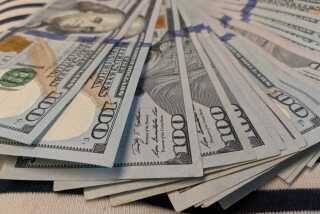Bush Urged to Take Action on Trade Problems
WASHINGTON â The improving U.S. trade deficit, the biggest factor promoting domestic growth last year, is on the verge of stalling out unless the Bush Administration moves quickly to devalue the dollar and reach a budget agreement with Congress, a research institute warned Monday.
The Institute for International Economics said that unless the United States is able to get its trade problems under control, the country faces the threat of a recession, triggered by the flight of foreigners from U.S. investments.
There is also a danger that a rising trade deficit would force Congress and the Administration to erect protectionist trade barriers that would threaten a global trade war, according to the study, âAmerican Trade Adjustment: the Global Impact.â
The report said without needed policy changes, Americaâs trade deficit will begin rising again in 1990 and by 1992 will surpass the record imbalance of $154 billion set in 1987.
The forecast covers the current account, the broadest measure of U.S. trade, because it includes not only trade in merchandise but also trade in services, primarily investment flows between countries.
The current account deficit shrank 12% to $135 billion in 1988 as a boom in U.S. export sales accounted for almost half of total economic growth last year.
The report said this improvement was about to stall out because high U.S. consumption spending was continuing to pull in imports while the dollarâs value was not low enough to spur further gains in U.S. export sales.
The report recommended that the Bush Administration persuade Americaâs major allies to accept a further devaluation of the dollar. It said the dollar needed to drop another 25% against the yen and another 20% against the West German mark.
Since February, 1987, the United States has promoted a dollar-stabilization effort in the face of protests from U.S. allies, including Japan and West Germany, that the greenback already had fallen enough from its highs in 1985.
The report called on the Bush Administration to work with Congress to meet the targets of the Gramm-Rudman deficit reduction law, which calls for a balanced budget by 1993.
William Cline, a senior fellow at the institute and the author of the report, said a reduction in the federal budget deficit would dampen the growth of domestic demand in this country and thus reduce Americaâs appetite for foreign goods.
The study said if the Bush Administration and Congress act quickly to implement the budget cuts, that would accomplish the shift from a consumption-driven economy to an export-driven economy without a recession.
C. Fred Bergsten, director of the institute, said the risks of a recession are greater now because in the past three years America has borrowed an additional $428 billion from the rest of the world to finance its huge current account deficits. Those deficits mean that Americans are handing over billions of dollars to foreigners to pay for imported products.
Unless the trade improvements are resumed, Americaâs net debt will top $1 trillion by the end of 1992, the report forecast. The net debt represents the excess in foreign investments in this country over what Americans own overseas.
The growing debt burdens run the risk of a âcollapse of confidence in the dollar, triggering a further surge of inflation and interest rates--and possibly a recession,â the report said.
Cline said the Administration should have as a goal lowering the current account deficit from $150 billion to an annual rate of $50 billion, which he said was a more realistic figure than trying for total elimination of the deficit.
The report, which used computer models to simulate global trade flows, reached these other conclusions:
* The U.S. trade deficit would drop by $9 billion to $13 billion in 1992 for every percentage point boost in growth in the economies of Americaâs major trading partners.
* The trade deficit would narrow by between $8 billion and $10 billion in 1992 for every percentage point decline in the dollarâs exchange rate value. The report said the trade-weighted value of the dollar against all currencies needed to fall by 10%.
* The trade deficit would improve by $15 billion for every percentage point drop in Americaâs economic growth rate, reflecting a lower demand for imports.
The institute is a non-partisan research organization which specializes in studies of international economic issues.
More to Read
Inside the business of entertainment
The Wide Shot brings you news, analysis and insights on everything from streaming wars to production â and what it all means for the future.
You may occasionally receive promotional content from the Los Angeles Times.










